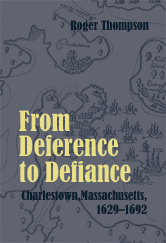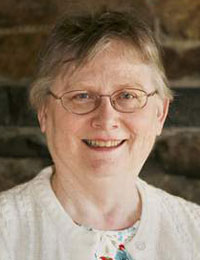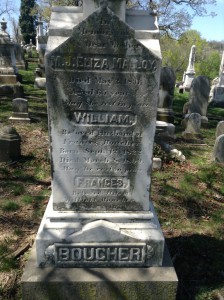 The “Great Migration” of as many as 20,000 people to New England during the 1630s was, in its long-term effects, the most important event in English seventeenth-century history. It has been depicted as a farther-reaching extension of an already mobile English population, though I have argued elsewhere that many emigrants to New England came from long-settled backgrounds. What distinguished the Great Migration was its family nature, as compared to the settling of the Chesapeake or the Caribbean, where individual young men predominated. Moreover, many arrivals in Salem, Charlestown, or Boston were members of “companies” – interrelated clans, or followers of gentlemen or ministers. Continue reading Early Charlestown companies
The “Great Migration” of as many as 20,000 people to New England during the 1630s was, in its long-term effects, the most important event in English seventeenth-century history. It has been depicted as a farther-reaching extension of an already mobile English population, though I have argued elsewhere that many emigrants to New England came from long-settled backgrounds. What distinguished the Great Migration was its family nature, as compared to the settling of the Chesapeake or the Caribbean, where individual young men predominated. Moreover, many arrivals in Salem, Charlestown, or Boston were members of “companies” – interrelated clans, or followers of gentlemen or ministers. Continue reading Early Charlestown companies
Organizing a family reunion: Part Three
 My cousin Connie recently sent me a photo of a young woman and asked me if I thought it might show her grandmother (and my great-great-aunt) Constance Boucher Burch (1887–1977). I’m inclined to think it does, given the provenance as well as the (rather unscientific) fact that this young woman has a family look: in features and coloring she reminds me of my grandmother Pauline Glidden Bell (1903–1968). (Click on images to expand them.) Continue reading Organizing a family reunion: Part Three
My cousin Connie recently sent me a photo of a young woman and asked me if I thought it might show her grandmother (and my great-great-aunt) Constance Boucher Burch (1887–1977). I’m inclined to think it does, given the provenance as well as the (rather unscientific) fact that this young woman has a family look: in features and coloring she reminds me of my grandmother Pauline Glidden Bell (1903–1968). (Click on images to expand them.) Continue reading Organizing a family reunion: Part Three
The Great Migration Study Project: a primer
 It is amazing to realize that the Great Migration Study Project is twenty-five years old. Part of my fifteen seconds of fame is that I was in the room when Great Migration Begins was chosen as the title for the first series of books! It is nice to see how many new researchers are getting a glimpse of the project through Vita Brevis.
It is amazing to realize that the Great Migration Study Project is twenty-five years old. Part of my fifteen seconds of fame is that I was in the room when Great Migration Begins was chosen as the title for the first series of books! It is nice to see how many new researchers are getting a glimpse of the project through Vita Brevis.
Robert Charles Anderson conceived the project as a modern “genealogical dictionary” of settlers who came to New England during the period we call the Great Migration, from 1620 through 1640. The project began as a consolidation and correction of material in print but soon expanded to include original research in New England and Old England. Continue reading The Great Migration Study Project: a primer
A considerable legacy in genealogy
 Samuel Gardner Drake was not a likely candidate to become the author of a multitude of historical works. Born on a farm in Pittsfield, New Hampshire, in 1798, he was not an eager pupil in his youth. “His aversion to school, when a little urchin,” as John H. Sheppard put it, “was particularly strong.” Drake recalled his initial dread of the school room: “My first impressions of that school were anything but pleasant. Being naturally very timid, I was sadly frightened at the stern look of the master. To learn my lessons seemed a desperate undertaking, and it was a long time before I could believe and feel I was not in danger of being annihilated.” Continue reading A considerable legacy in genealogy
Samuel Gardner Drake was not a likely candidate to become the author of a multitude of historical works. Born on a farm in Pittsfield, New Hampshire, in 1798, he was not an eager pupil in his youth. “His aversion to school, when a little urchin,” as John H. Sheppard put it, “was particularly strong.” Drake recalled his initial dread of the school room: “My first impressions of that school were anything but pleasant. Being naturally very timid, I was sadly frightened at the stern look of the master. To learn my lessons seemed a desperate undertaking, and it was a long time before I could believe and feel I was not in danger of being annihilated.” Continue reading A considerable legacy in genealogy
Family plots
 A colleague and old friend delights in killing people off: that is, finding the death and burial information of ancestors and other family members. When we are content to list a relative as having been born and later married, with no end date or place in our record-keeping, we are forgoing information that might explain biographical mysteries. By focusing on our direct ancestry without sparing a glance to collateral relatives or unexplained members of a household, we might well be overlooking the answer to an intractable research problem. I recently made the rounds of many of the cemeteries where my relatives are buried, but one that I did not visit this winter led me, years ago, to a break-through on my matrilineal line. Continue reading Family plots
A colleague and old friend delights in killing people off: that is, finding the death and burial information of ancestors and other family members. When we are content to list a relative as having been born and later married, with no end date or place in our record-keeping, we are forgoing information that might explain biographical mysteries. By focusing on our direct ancestry without sparing a glance to collateral relatives or unexplained members of a household, we might well be overlooking the answer to an intractable research problem. I recently made the rounds of many of the cemeteries where my relatives are buried, but one that I did not visit this winter led me, years ago, to a break-through on my matrilineal line. Continue reading Family plots
Special collections at NEHGS
 Among the holdings of the New England Historic Genealogical Society is an extensive collection of manuscripts dedicated to genealogical and local history material. Filling more than 5,000 feet of shelving and containing over 28 million individual items (some of which date back to the fourteenth century), this collection, known as the R. Stanton Avery Special Collections, offers members an incredible repository of information.
Among the holdings of the New England Historic Genealogical Society is an extensive collection of manuscripts dedicated to genealogical and local history material. Filling more than 5,000 feet of shelving and containing over 28 million individual items (some of which date back to the fourteenth century), this collection, known as the R. Stanton Avery Special Collections, offers members an incredible repository of information.
Individual entries are arranged by call number, which groups the items according to format: Continue reading Special collections at NEHGS
A sense of place and name
 The question from the previous post was: “What if John Smith and Mary Brown lived in Barnstable but Abigail Smith and Harry Carey were married at Sandwich?” Barnstable and Sandwich are right next to each other, so why would this raise a red flag?
The question from the previous post was: “What if John Smith and Mary Brown lived in Barnstable but Abigail Smith and Harry Carey were married at Sandwich?” Barnstable and Sandwich are right next to each other, so why would this raise a red flag?
Although this example involves an early nineteenth-century wedding (1816), and the rules of posting banns and other restrictions of earlier centuries were becoming less common, in New England towns there was still a strong tie to church and community. Girls married in the church to which their families belonged. John and Mary (Brown) Smith belonged to the church in Barnstable – what would their daughter be doing getting married in Sandwich? Continue reading A sense of place and name
“The Good lord direct us”: a New England love quadrangle, 1648-49
 In December 1648, Lucy (Winthrop) Downing sent her nephew John2 Winthrop a letter full of family news: her husband, Emmanuel Downing, had been at the birth of John’s baby half-brother, Joshua, the week before, and “I belleeue our cosen Dorithe Simonds is nowe wonne and weded to Mr. Harrison the Virginia minister.” Sounding at once like a modern-day gossip and a character in Pride and Prejudice, Mrs. Downing also noted that her daughter Lucy would probably soon marry: Continue reading “The Good lord direct us”: a New England love quadrangle, 1648-49
In December 1648, Lucy (Winthrop) Downing sent her nephew John2 Winthrop a letter full of family news: her husband, Emmanuel Downing, had been at the birth of John’s baby half-brother, Joshua, the week before, and “I belleeue our cosen Dorithe Simonds is nowe wonne and weded to Mr. Harrison the Virginia minister.” Sounding at once like a modern-day gossip and a character in Pride and Prejudice, Mrs. Downing also noted that her daughter Lucy would probably soon marry: Continue reading “The Good lord direct us”: a New England love quadrangle, 1648-49
Organizing a family reunion: Part Two
The organizers of the William Boucher reunion are starting with incomplete information about the family, as often happens. My cousins Cheryl and Connie and I all have lists of William Boucher’s descendants, but of course these lists are more accurate about Boucher’s children – Willy, Sophia, Freddie, Oscar, Frank, Imogene, Pauline, Victor, Josephine, Willy, Josephine, Gertrude, Louis, Frances, Marie, Pauline, Ernest, Carlos, Florence, Emile, Constance, and (yes) Emile and Constance – than about modern-day descendants. How best to find today’s Boucher family? Continue reading Organizing a family reunion: Part Two
“To tell and retell the stories of their lives”
 Every year at this time, the New England Historic Genealogical Society holds its annual meeting here in Boston. This year, the program began on Thursday with a lunch for board members, councilors, and other out-of-town guests, followed by tours of the Society’s new building at 97 Newbury Street and the new conservation laboratory at 99–101 Newbury Street. Friday was devoted to committee and other meetings for the board and council, culminating in a gala dinner where presidential historian Doris Kearns Goodwin received the Society’s Lifetime Achievement Award for American History and Biography. Ms. Goodwin was given a hand bound copy of a genealogy commissioned by the Society and compiled by Chris Child and David Allen Lambert, and she spoke to the group about “Everlasting Legacies”; her address had the epigraph “The people we love will live on so long as we pledge to tell and retell the stories of their lives.” Continue reading “To tell and retell the stories of their lives”
Every year at this time, the New England Historic Genealogical Society holds its annual meeting here in Boston. This year, the program began on Thursday with a lunch for board members, councilors, and other out-of-town guests, followed by tours of the Society’s new building at 97 Newbury Street and the new conservation laboratory at 99–101 Newbury Street. Friday was devoted to committee and other meetings for the board and council, culminating in a gala dinner where presidential historian Doris Kearns Goodwin received the Society’s Lifetime Achievement Award for American History and Biography. Ms. Goodwin was given a hand bound copy of a genealogy commissioned by the Society and compiled by Chris Child and David Allen Lambert, and she spoke to the group about “Everlasting Legacies”; her address had the epigraph “The people we love will live on so long as we pledge to tell and retell the stories of their lives.” Continue reading “To tell and retell the stories of their lives”
